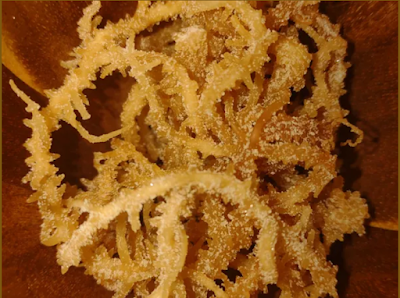 |
| Species: Wildcrafted Gracilaria from Tanzania |
When shopping around for the superfood sea moss, it is important to understand the difference between wild harvested or wildcrafted and pool grown sea moss. This sea algae can be found along the Atlantic Ocean's rocky shores between North America and Europe. Other seaweed and algae species, including sea moss variations, flourish in warmer ocean waters in the Caribbean, South America, Asia, and Africa. This nutrient dense sea vegetable is a rich source of vitamins, minerals, and antioxidants, and has been used for centuries for its medicinal properties. There are two main types of sea moss available in the market: wildcrafted and pool-grown. In this blog, we will compare the differences between these two types of sea moss.
Wildcrafted sea moss is harvested directly from the ocean and is considered to be of highest quality as it is grown in its natural environment.
 |
| Pool Grown Sea Moss |
One of the main differences between the two is the nutrient profile. Wildcrafted sea moss is richer in nutrients such as iodine, magnesium, calcium, and iron, as it is grown in its natural environment and is not subjected to any artificial additives. Pool-grown sea moss, on the other hand, may have a lower nutrient density as it is grown in a controlled environment and is subject to artificial fertilizers and chemicals.
Another difference between the two types is the taste and texture. Wildcrafted sea moss is considered to have a better flavor and a smoother texture that will have debris from the ocean attached such as than pool-grown sea moss. This is due to the natural growth and development of the seaweed, which leads to a more complex flavor profile and a more delicate texture. When looking for wildcrafted, it is important to look for signs of sea life such as sea shells. The Garcilaria species as shown in the top image above will have a a stringy texture and comes in a variety of colors depending on the region. Pool-grown sea moss, on the other hand, may have a more bland flavor and a coarser texture due to the controlled growth conditions and being salted heavily. The tentacles tend to be short and stubby as well.
In terms of sustainability, wildcrafted sea moss is considered to be more environmentally friendly. The harvesting of wildcrafted sea moss is done in a way that minimizes damage to the natural environment, and ensures that the seaweed is able to regenerate and grow back. Pool-grown sea moss, on the other hand, requires the use of artificial pools or tanks, which can have a negative impact on the environment due to the use of energy and resources.
In conclusion, it is important to consider the quality, nutrient profile, taste, and sustainability when making a choice between the two. If you are looking for a high-quality, nutrient-dense, and flavorful sea moss, then wildcrafted sea moss is the way to go. Ultimately, it is your duty as a consumer to make the best decision for your health.
Comments
Post a Comment